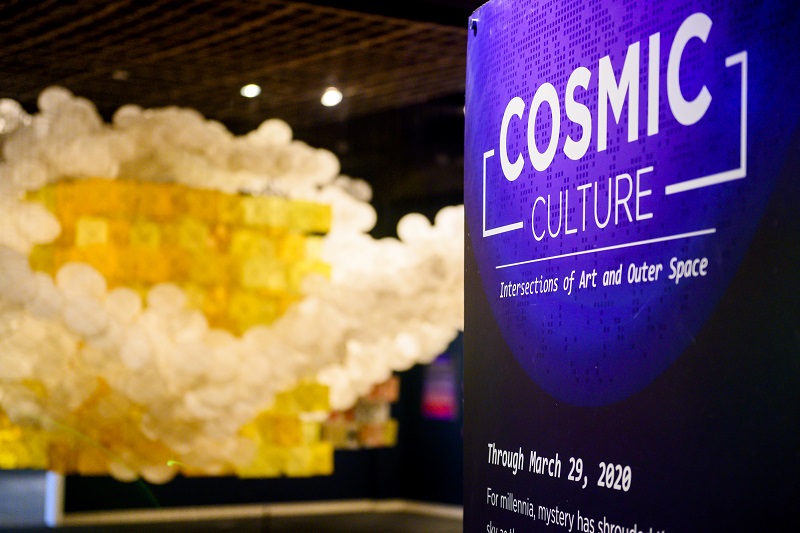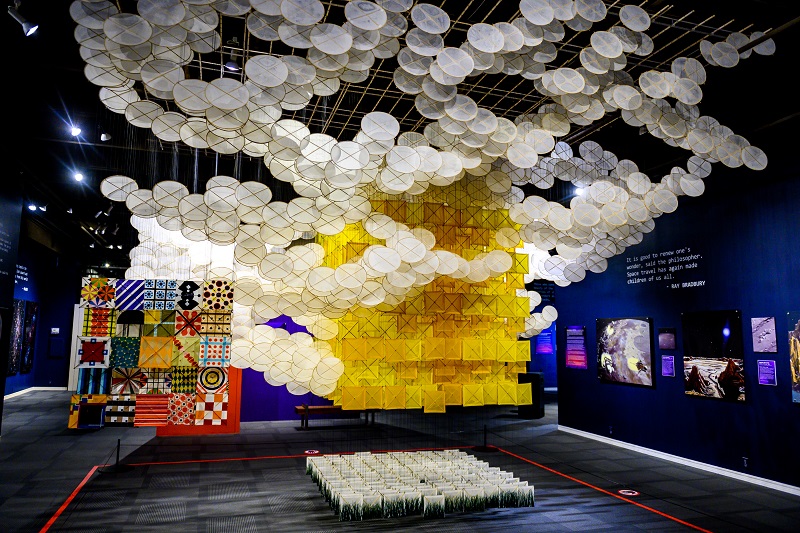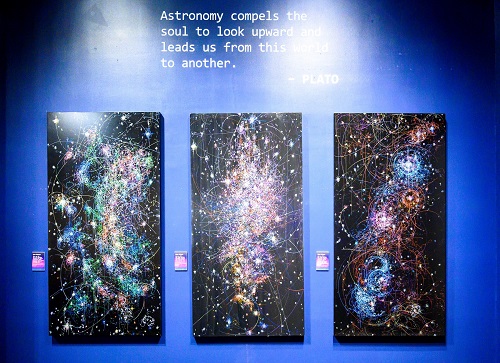Thousands of Paper Kites Soar Into Science Museum Oklahoma in New Exhibition Exploring the Intersection of Art and Outer Space
October 4, 2019
Jacob Hashimoto’s “The Other Sun” is the centerpiece of Science Museum Oklahoma’s “Cosmic Culture: Intersections of Art and Outer Space,” now open in the museum’s smART Space galleries.
Originally scheduled to close in March 2020, due to COVID-19 "Cosmic Culture" will be extended through mid-September 2020 with the exception of Jacob Hashimoto's "The Other Sun," which will only be on exhibit through June 30.
Thousands of bright paper kites, hundreds of embroidery stitches, ink-on-board drawings, photography, mixed media and historical images that illuminate how space exploration and visual art have influenced each other are now on display in Science Museum Oklahoma’s smART Space as part of “Cosmic Culture: Intersections of Art and Outer Space.”
The exhibition is heliocentric, revolving around Jacob Hashimoto’s “The Other Sun,” a Minecraft-inspired installation made from 2,000 bamboo-and-paper kites. A New York-based contemporary artist, Hashimoto creates complex worlds from a range of modular components like the bamboo-and-paper kites on exhibit at SMO.

“Cosmic Culture: Intersections of Art and Outer Space,” now open in the museum’s smART
Space galleries.
“This is a unique exhibition incorporating a wide array of artistic media to explore the wonder of — and fascination with — outer space. From Jacob Hashimoto’s paper kite installation depicting the sun to Darci Lenker’s tiny embroideries illustrating galactic imagery, I think every guest will find something to marvel at in ‘Cosmic Culture,’” said smART Space Curator Alyson Atchison.
Guests can circle the gallery and see 1940s and ‘50s prints from science fiction artist Chesley Bonestell — an inspiration to astronomer and astrophysicist Carl Sagan — alongside NASA images taken decades later, historic star charts from around the world, planetary landscapes, the lifecycle of stars, a mixed media installation from reclaimed materials, a feed of NASA images of the sun, and much more.
Featured contemporary artists include Carrie Dickason, Tulsa, Oklahoma; Cassandra Hanks, Los Angeles; Hashimoto, New York; Kysa Johnson, Los Angeles; and Lenker, Norman, Oklahoma.
“For centuries, the arts and sciences were essentially fused in innovative approaches to document the path of discovery and human knowledge of our world. Artists, scientists, scholars, natural philosophers and theologians were bound by a unified mission to present such a vast subject within the frame of an image,” Atchison added.

using the formula for subatomic decay.
“‘Cosmic Culture’ is a colorful testimony of awe, discovery and understanding of the moon, stars, Earth, sun, and more — art and space exploration have influenced each other more than most realize.”
“Cosmic Culture: Intersections of Art and Outer Space” is open in smART Space through March 29, 2020, and is included with general admission.
Located at 2020 Remington Pl. in Oklahoma City, Science Museum Oklahoma is open from 9 a.m. to 5 p.m. Monday through Friday; 9 a.m. to 6 p.m. Saturday; and 11 a.m. to 6 p.m. Sunday. The museum is closed on Thanksgiving, Christmas Eve and Christmas Day. Daily general admission is $16.95 for adults (ages 13 to 64) and $13.95 for children and seniors (ages 3 to 12 and 65 and older). Annual memberships begin at $105.
For more information about the smART Space galleries at Science Museum Oklahoma, visit www.sciencemuseumok.org/smart-space.
###


